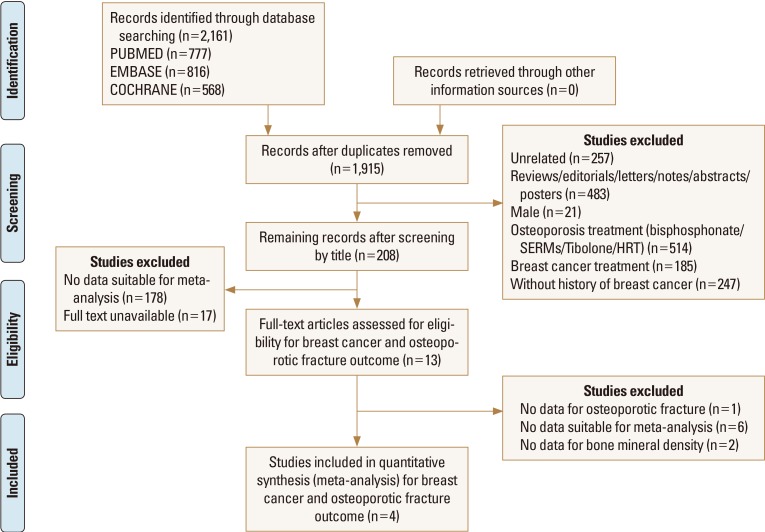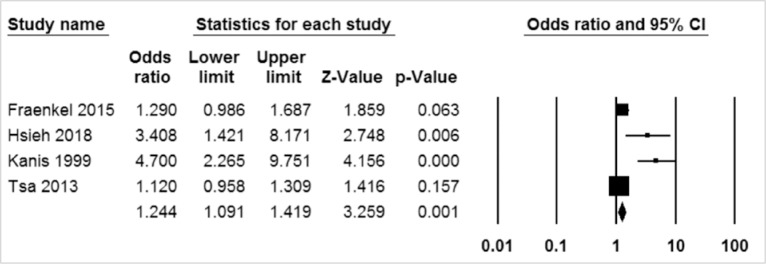J Bone Metab.
2020 Feb;27(1):27-34. 10.11005/jbm.2020.27.1.27.
Risk of Osteoporotic Fracture in Patients with Breast Cancer: Meta-Analysis
- Affiliations
-
- 1Department of Surgery, Center for Breast Cancer, Research Institute and Hospital, National Cancer Center, Goyang, Korea.
- 2Department of Orthopaedic Surgery, Gyeongsang National University Hospital, Jinju, Korea.
- 3Department of Orthopaedic Surgery, Seoul National University Bundang Hospital, Seoul National University College of Medicine, Seongnam, Korea. ykleemd@gmail.com
- 4Department of Orthopaedic Surgery, Chung-Ang University College of Medicine, Seoul, Korea.
- KMID: 2471311
- DOI: http://doi.org/10.11005/jbm.2020.27.1.27
Abstract
- BACKGROUND
The fracture risk induced by anti-estrogen therapy in patients with breast cancer remains controversial. The aim of this study was to perform a meta-analysis and systematic review to evaluate the risk of osteoporotic fracture in patients with breast cancer.
METHODS
A systematic search was performed to identify studies that included any osteoporotic fracture (hip fracture and vertebral fracture) in patients breast cancer. Main outcome measures were occurrence and risk of osteoporotic fractures including hip and vertebral fractures in patients and controls.
RESULTS
A systematic search yielded a total of 4 studies that included osteoporotic fracture outcomes in patients with breast cancer. Meta-analysis showed a higher risk of osteoporotic fracture in patients with breast cancer. Analysis of these 4 studies involving a total of 127,722 (23,821 cases and 103,901 controls) patients showed that the incidence of osteoporotic fractures was higher in the breast cancer group than in the control group. The pooled estimate of crude relative risk for osteoporotic fracture was 1.35 (95% confidence interval, 1.29-1.42; P<0.001).
CONCLUSIONS
Although studies were limited by a small number, results suggested a possible association between anti-estrogen therapy and increased risk of osteoporotic fractures in patients with breast cancer.
MeSH Terms
Figure
Reference
-
1. National Institutes of Health. Cancer stat facts: Female breast cancer. 2019. cited by 2019 Nov 26. Available from: https://seer.cancer.gov/statfacts/html/breast.html.2. Yap YS, Lu YS, Tamura K, et al. Insights into breast cancer in the east vs the west: A review. JAMA Oncol. 2019; DOI: 10.1001/jamaoncol.2019.0620.3. Howlader N, Altekruse SF, Li CI, et al. US incidence of breast cancer subtypes defined by joint hormone receptor and HER2 status. J Natl Cancer Inst. 2014; DOI: 10.1093/jnci/dju055.
Article4. Goldhirsch A, Wood WC, Coates AS, et al. Strategies for subtypes-dealing with the diversity of breast cancer: highlights of the St. Gallen International Expert Consensus on the Primary Therapy of Early Breast Cancer 2011. Ann Oncol. 2011; 22:1736–1747. PMID: 21709140.
Article5. Dowsett M, Cuzick J, Ingle J, et al. Meta-analysis of breast cancer outcomes in adjuvant trials of aromatase inhibitors versus tamoxifen. J Clin Oncol. 2010; 28:509–518. PMID: 19949017.
Article6. Mauri D, Pavlidis N, Polyzos NP, et al. Survival with aromatase inhibitors and inactivators versus standard hormonal therapy in advanced breast cancer: meta-analysis. J Natl Cancer Inst. 2006; 98:1285–1291. PMID: 16985247.
Article7. Becker T, Lipscombe L, Narod S, et al. Systematic review of bone health in older women treated with aromatase inhibitors for early-stage breast cancer. J Am Geriatr Soc. 2012; 60:1761–1767. PMID: 22985145.
Article8. Hadji P. Aromatase inhibitor-associated bone loss in breast cancer patients is distinct from postmenopausal osteoporosis. Crit Rev Oncol Hematol. 2009; 69:73–82. PMID: 18757208.
Article9. Lee SJ, Kim KM, Brown JK, et al. Negative impact of aromatase inhibitors on proximal femoral bone mass and geometry in postmenopausal women with breast cancer. Calcif Tissue Int. 2015; 97:551–559. PMID: 26232103.
Article10. Kyvernitakis I, Rachner TD, Urbschat A, et al. Effect of aromatase inhibition on serum levels of sclerostin and dickkopf-1, bone turnover markers and bone mineral density in women with breast cancer. J Cancer Res Clin Oncol. 2014; 140:1671–1680. PMID: 24903965.
Article11. Coleman RE, Banks LM, Girgis SI, et al. Skeletal effects of exemestane on bone-mineral density, bone biomarkers, and fracture incidence in postmenopausal women with early breast cancer participating in the Intergroup Exemestane Study (IES): a randomised controlled study. Lancet Oncol. 2007; 8:119–127. PMID: 17267326.
Article12. Goss PE, Ingle JN, Martino S, et al. Randomized trial of letrozole following tamoxifen as extended adjuvant therapy in receptor-positive breast cancer: updated findings from NCIC CTG MA.17. J Natl Cancer Inst. 2005; 97:1262–1271. PMID: 16145047.13. Cuzick J, Sestak I, Baum M, et al. Effect of anastrozole and tamoxifen as adjuvant treatment for early-stage breast cancer: 10-year analysis of the ATAC trial. Lancet Oncol. 2010; 11:1135–1141. PMID: 21087898.
Article14. Rabaglio M, Sun Z, Price KN, et al. Bone fractures among postmenopausal patients with endocrine-responsive early breast cancer treated with 5 years of letrozole or tamoxifen in the BIG 1-98 trial. Ann Oncol. 2009; 20:1489–1498. PMID: 19474112.
Article15. Forbes JF, Cuzick J, Buzdar A, et al. Effect of anastrozole and tamoxifen as adjuvant treatment for early-stage breast cancer: 100-month analysis of the ATAC trial. Lancet Oncol. 2008; 9:45–53. PMID: 18083636.16. Amir E, Seruga B, Niraula S, et al. Toxicity of adjuvant endocrine therapy in postmenopausal breast cancer patients: a systematic review and meta-analysis. J Natl Cancer Inst. 2011; 103:1299–1309. PMID: 21743022.
Article17. Taxel P, Faircloth E, Idrees S, et al. Cancer treatment-induced bone loss in women with breast cancer and men with prostate cancer. J Endocr Soc. 2018; 2:574–588. PMID: 29942922.
Article18. Melton LJ, 3rd , Hartmann LC, Achenbach SJ, et al. Fracture risk in women with breast cancer: a population-based study. J Bone Miner Res. 2012; 27:1196–1205. PMID: 22258822.
Article19. Shamseer L, Moher D, Clarke M, et al. Preferred reporting items for systematic review and meta-analysis protocols (PRISMA-P) 2015: elaboration and explanation. BMJ. 2016; 354:i4086. PMID: 27444514.
Article20. Fraenkel M, Geffen DB, Novack V, et al. Breast cancer survivors are at an increased risk for osteoporotic fractures not explained by lower BMD: a retrospective analysis. NPJ Breast Cancer. 2015; 1:15010. PMID: 28721367.
Article21. Hsieh E, Wang Q, Zhang R, et al. Vertebral fractures among breast cancer survivors in China: a cross-sectional study of prevalence and health services gaps. BMC Cancer. 2018; 18:104. PMID: 29378534.
Article22. Kanis JA, McCloskey EV, Powles T, et al. A high incidence of vertebral fracture in women with breast cancer. Br J Cancer. 1999; 79:1179–1181. PMID: 10098755.
Article23. Tsai CH, Muo CH, Tzeng HE, et al. Fracture in asian women with breast cancer occurs at younger age. PLoS One. 2013; 8:e75109. PMID: 24069386.
Article24. Lo JC, Burnett-Bowie SA, Finkelstein JS. Bone and the perimenopause. Obstet Gynecol Clin North Am. 2011; 38:503–517. PMID: 21961717.
Article25. de Cremoux P, Diéras V, Poupon MF, et al. Tamoxifen and aromatase inhibitors in the treatment of breast cancer in menopausal women: pharmacological and clinical aspects. Bull Cancer. 2004; 91:917–927. PMID: 15634633.26. Hofbauer LC, Rachner TD, Hamann C. From bone to breast and back - the bone cytokine RANKL and breast cancer. Breast Cancer Res. 2011; 13:107. PMID: 21635706.
Article27. Kalder M, Hadji P. Breast cancer and osteoporosis - management of cancer treatment-induced bone loss in postmenopausal women with breast cancer. Breast Care (Basel). 2014; 9:312–317. PMID: 25759610.
Article28. Sheean P, Liang H, Schiffer L, et al. Assessing the prevalence of compromised bone health among overweight and obese African-American breast cancer survivors: a case-control study. J Cancer Surviv. 2016; 10:21–30. PMID: 25820976.
Article29. Boman A, Kokkonen H, Ärlestig L, et al. Receptor activator of nuclear factor kappa-B ligand (RANKL) but not sclerostin or gene polymorphisms is related to joint destruction in early rheumatoid arthritis. Clin Rheumatol. 2017; 36:1005–1012. PMID: 28190118.
Article30. Lee J, Park C, Kim HJ, et al. Stimulation of osteoclast migration and bone resorption by C-C chemokine ligands 19 and 21. Exp Mol Med. 2017; 49:e358. PMID: 28729639.
Article31. Fata JE, Kong YY, Li J, et al. The osteoclast differentiation factor osteoprotegerin-ligand is essential for mammary gland development. Cell. 2000; 103:41–50. PMID: 11051546.
Article32. Tremollieres FA, Ceausu I, Depypere H, et al. Osteoporosis management in patients with breast cancer: EMAS position statement. Maturitas. 2017; 95:65–71. PMID: 27802892.
Article33. Manolagas SC. From estrogen-centric to aging and oxidative stress: a revised perspective of the pathogenesis of osteoporosis. Endocr Rev. 2010; 31:266–300. PMID: 20051526.
Article34. Maeda SS, Lazaretti-Castro M. An overview on the treatment of postmenopausal osteoporosis. Arq Bras Endocrinol Metabol. 2014; 58:162–171. PMID: 24830593.
Article35. Yue W, Wang JP, Li Y, et al. Effects of estrogen on breast cancer development: Role of estrogen receptor independent mechanisms. Int J Cancer. 2010; 127:1748–1757. PMID: 20104523.
Article36. Hsu LH, Chu NM, Kao SH. Estrogen, estrogen receptor and lung cancer. Int J Mol Sci. 2017; DOI: 10.3390/ijms18081713.
Article37. Nishimukai A, Higuchi T, Ozawa H, et al. Different patterns of change in bone turnover markers during treatment with bone-modifying agents for breast cancer patients with bone metastases. Breast Cancer. 2017; 24:245–253. PMID: 27040403.
Article38. Banfi G, Iorio EL, Corsi MM. Oxidative stress, free radicals and bone remodeling. Clin Chem Lab Med. 2008; 46:1550–1555. PMID: 18847368.
Article39. Domazetovic V, Marcucci G, Iantomasi T, et al. Oxidative stress in bone remodeling: role of antioxidants. Clin Cases Miner Bone Metab. 2017; 14:209–216. PMID: 29263736.
Article40. Wauquier F, Leotoing L, Coxam V, et al. Oxidative stress in bone remodelling and disease. Trends Mol Med. 2009; 15:468–477. PMID: 19811952.
Article41. Baek KH, Oh KW, Lee WY, et al. Association of oxidative stress with postmenopausal osteoporosis and the effects of hydrogen peroxide on osteoclast formation in human bone marrow cell cultures. Calcif Tissue Int. 2010; 87:226–235. PMID: 20614110.
Article42. Fontani F, Marcucci G, Iantomasi T, et al. Glutathione, N-acetylcysteine and lipoic acid down-regulate starvation-induced apoptosis, RANKL/OPG ratio and sclerostin in osteocytes: involvement of JNK and ERK1/2 signalling. Calcif Tissue Int. 2015; 96:335–346. PMID: 25660312.
Article43. Ueno T, Yamada M, Igarashi Y, et al. N-acetyl cysteine protects osteoblastic function from oxidative stress. J Biomed Mater Res A. 2011; 99:523–531. PMID: 21913320.
Article44. Hecht F, Pessoa CF, Gentile LB, et al. The role of oxidative stress on breast cancer development and therapy. Tumour Biol. 2016; 37:4281–4291. PMID: 26815507.
Article45. Yu T, Di G. Role of tumor microenvironment in triple-negative breast cancer and its prognostic significance. Chin J Cancer Res. 2017; 29:237–252. PMID: 28729775.
Article46. Chen Y, Zeng C, Zhan Y, et al. Aberrant low expression of p85alpha in stromal fibroblasts promotes breast cancer cell metastasis through exosome-mediated paracrine Wnt10b. Oncogene. 2017; 36:4692–4705. PMID: 28394344.47. Bussard KM, Mutkus L, Stumpf K, et al. Tumor-associated stromal cells as key contributors to the tumor microenvironment. Breast Cancer Res. 2016; 18:84. PMID: 27515302.
Article48. Ettinger B, Pressman A, Sklarin P, et al. Associations between low levels of serum estradiol, bone density, and fractures among elderly women: the study of osteoporotic fractures. J Clin Endocrinol Metab. 1998; 83:2239–2243. PMID: 9661589.
Article49. Buzdar AU, Robertson JF, Eiermann W, et al. An overview of the pharmacology and pharmacokinetics of the newer generation aromatase inhibitors anastrozole, letrozole, and exemestane. Cancer. 2002; 95:2006–2016. PMID: 12404296.
Article50. Pfeilschifter J. Role of cytokines in postmenopausal bone loss. Curr Osteoporos Rep. 2003; 1:53–58. PMID: 16036065.
Article51. Shimodaira K, Fujikawa H, Okura F, et al. Osteoblast cells (MG-63 and HOS) have aromatase and 5 alpha-reductase activities. Biochem Mol Biol Int. 1996; 39:109–116. PMID: 8799333.
- Full Text Links
- Actions
-
Cited
- CITED
-
- Close
- Share
- Similar articles
-
- Osteoporotic Fractures of the Spine, Hip, and Other Locations after Adjuvant Endocrine Therapy with Aromatase Inhibitors in Breast Cancer Patients: a Meta-analysis
- The Efficacy of Bisphosphonates for Prevention of Osteoporotic Fracture: An Update Meta-analysis
- Risk of Osteoporotic Fractures after Thyroid-stimulating Hormone Suppression Therapy in Patients with Thyroid Cancer
- Effect of Brace to Osteoporotic Vertebral Fracture: a Meta-Analysis
- Osteoporosis and Osteoporotic Fracture in Premature Menopause



